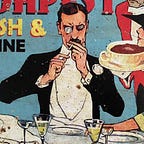Understanding the GameStop Saga — Part Five: #OccupyWallstreetBets, David vs Goliath?
In Part I, we explained how GameStop stock was a logical short selling target to hedge funds and other investors. In Part II, we saw that GameStop stock was so oversold it was ripe for a short squeeze. We also reviewed the mechanisms of a short squeeze and how much damage it may cause during violent episode. In Part III, we looked how easy-money policies built a gigantic bubble that gave many Americans the feeling of getting rich before it all came down crashing. In its aftermath, policymakers took unprecedented steps to stabilize the system which seemed to benefit those who caused the crisis at the expense of average taxpayers and the risk of reinflating an even bigger bubble. In Part IV, we saw the deep and hastening economic inequality caused in part by these same decades-long policies.
Here we will put all the pieces together to attempt to understand the deeper significance of the GameStop Saga
PART V: OccupyWallstreetBets: David vs Goliath?
The Global recession triggered, directly or indirectly, many other events around the world: the European debt crisis (2009), the Icelandic financial crisis (2008), and the spark to Arab Spring (Dec 2010 partly due to rising energy and food prices) to name a few.
Back then, these events made it clear that the system is not working for most. In September 2011, the Occupy Wall Street (OWS) movement protested economic inequality, corruption and greed and was a window to the rising frustration and resentment felt by many. “We are the 99%” the slogan said. Even then-president Barack Obama admitted that the movement expressed “the frustrations the American people feel, that we had the biggest financial crisis since the Great Depression… and yet you’re still seeing some of the same folks who acted irresponsibly trying to fight efforts to crack down on the abusive practices that got us into this in the first place.”
Yet still, nothing changed, most forgot but few never got over it.
During January 2021, GameStop saw its stock price whiplash from around $17 to $500. Although short squeezes are a regular occurrence even in a healthy market, what makes this one different and significant, is that, as Ray Dalio suggests, it is a reminder that the “system” is still not working for most people, a symptom of division and inequality.
This is for you dad! is how one of the posters on r/wallstreetbets discussion board justified his decision, with little regards to the economics of his trade, to inflict pain on the amorphous Wall Street bad guys. Resentment and a will to vengeance. But that alone would not have been enough without 2 new ingredients: democratization of trading through low-barrier platforms and a social media where amateur young traders, caught in the midst of a rising tide bubble, talked, self-organized and coordinated.
But like in every story, it is complicated. This was not a Robinhood story either (pun intended.) Beside the vigilantes, there were also those who realized the power of crowds on social media to execute such trading strategies. Pump-and-dump schemes were not the exclusive preserve of the big boys anymore. And then, indicative of a bubble in its advanced stages, there were those who bought “meme stocks” just because they were trending, many of whom were left holding the bag.
In those first days, there were many failures to deliver GameStop stock — which is sometimes indicative of the illegal practice of naked short selling. As often happens in a distorted market, even savvy investors get complacent and lazy and pile up on “profitable” trades: making it ripe for outsized shocks. So some hedge funds did suffer substantial losses and few were close to blowing up as a result, to the delight of some. On the other hand, many, including the same maligned hedge funds participated in and profited from the short squeeze.
Robinhood, the commission-free trading app most popular with these reddit traders, enraged its customers as it moved to halt buying in these shares at the height of the buying spree to cause the short-squeeze. Accusations of collusion and manipulation came from both users and Congress. The market regulator SEC suspended trading in even more “meme” securities in February, kindling the conviction for many that the table is tilted against small retail investors. Following the events, congressional hearing also investigated allegations of selling customer orders by Robinhood to market-makers and the practice of front-running these customer orders by HFT. To paraphrase the old investment dictum states: there are no commission-free lunch and Robinhood users re-learned the lesson that if you are not paying for it, you are the product.
The unusual high price and volatility of many of these meme stocks continues to this day but will certainly taper off.
The underlying story however will remain. It is a story about unresolved economic dislocations and remedies put in place to mask the consequences causing more vulnerabilities in the system and the destruction of the market as a mechanism for price discovery and efficient allocation of capital and resources where even short-selling serves a healthy role in the ecosystem. A story of an all-encompassing bubble that is bound to implode in a spectacular fashion. A story of worsening wealth divide and unwillingness to resolve the wealth redistribution part of the equation. And while it is not the beginning of a civil war as Ray Dalio warned if nothing is fixed, the GameStop episode proved to be a small tectonic plate tremor… or a warning for those who want to heed it.
